Less: COGS Closing stock 267000 COGS 413700 COGS Heating and Lighting 5320 (4400) Heating and lighting 5320 (4400) Heating and lighting 5320 (4400) Heating and lighting 5320 (4400) Heating and lightin
VerifiedAdded on 2022/11/25
|8
|1216
|301
AI Summary
ACCOUNTING Question 1 .3 a) Income statement .3 (b) Balance sheet.3 Question 2 .4 (a)4 (B) .4 (c)5 (D) .5 Question 3 .5 (a)5 (b)6 (c)6 (d)6 Question 4 .6 (a)6 (b)7 (c)7 (d)7 REFERENCES 7 Question 1 a) Income statement Sales 999000 Less
Contribute Materials
Your contribution can guide someone’s learning journey. Share your
documents today.
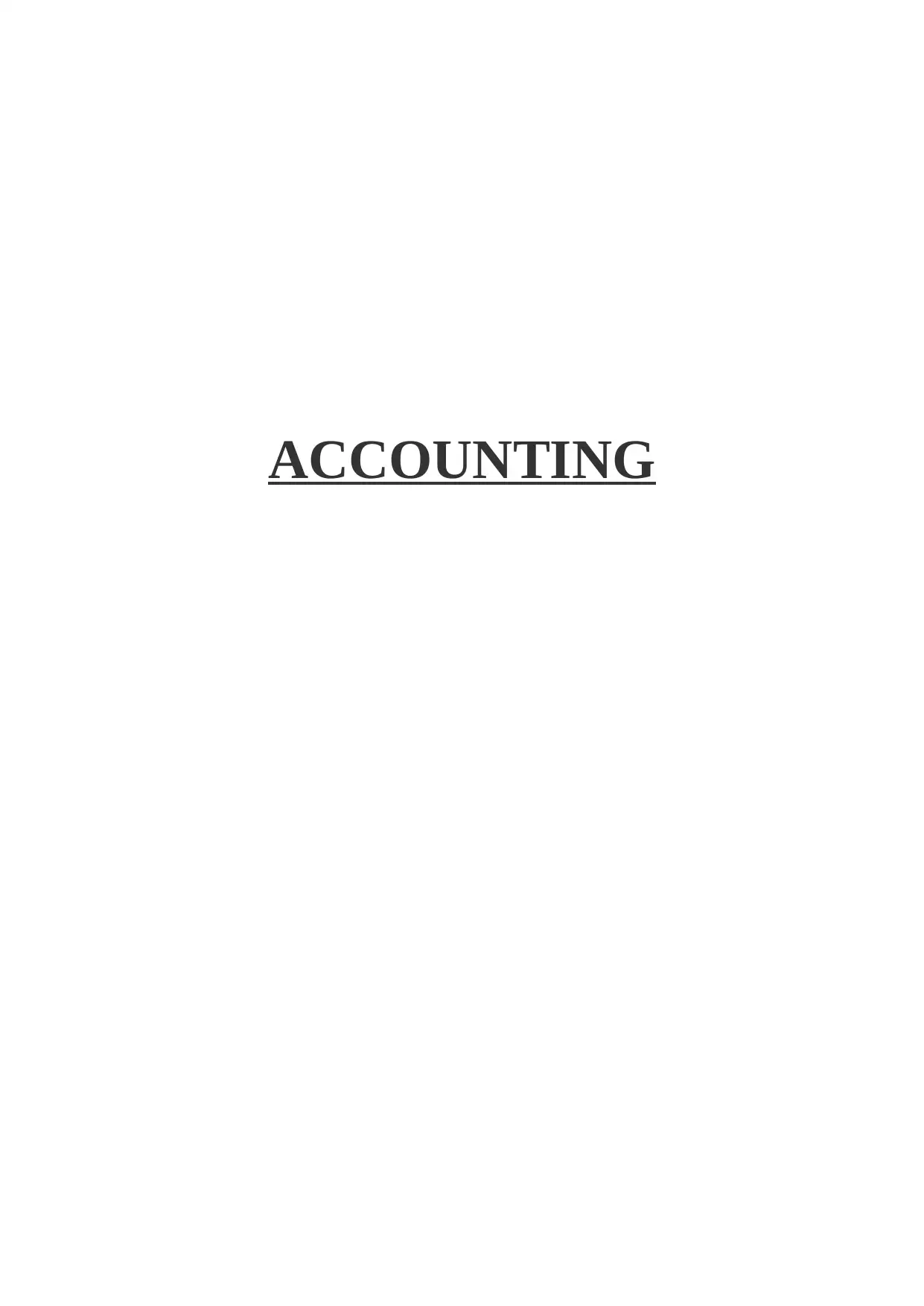
ACCOUNTING
Secure Best Marks with AI Grader
Need help grading? Try our AI Grader for instant feedback on your assignments.
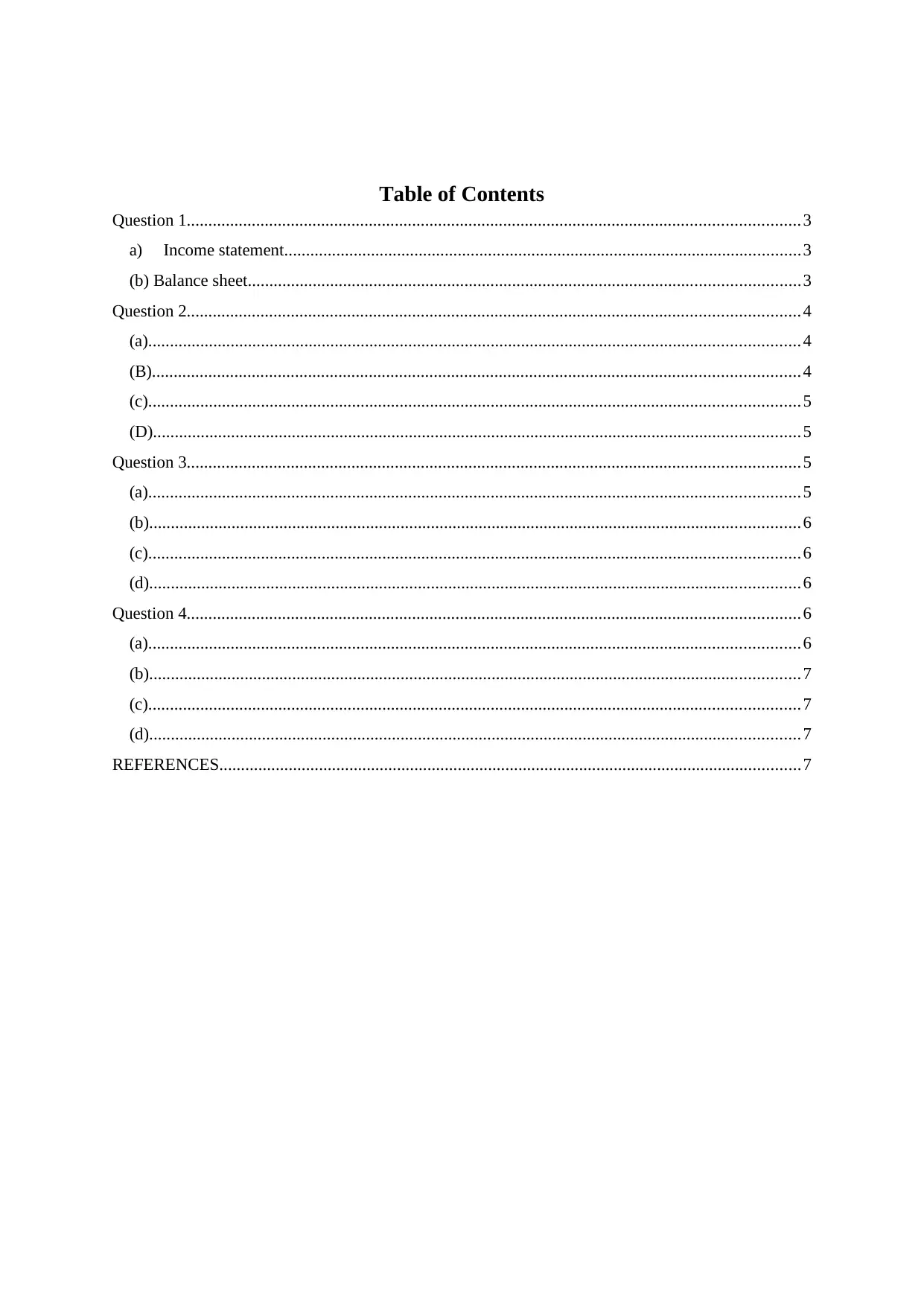
Table of Contents
Question 1.............................................................................................................................................3
a) Income statement.......................................................................................................................3
(b) Balance sheet...............................................................................................................................3
Question 2.............................................................................................................................................4
(a)......................................................................................................................................................4
(B).....................................................................................................................................................4
(c)......................................................................................................................................................5
(D).....................................................................................................................................................5
Question 3.............................................................................................................................................5
(a)......................................................................................................................................................5
(b)......................................................................................................................................................6
(c)......................................................................................................................................................6
(d)......................................................................................................................................................6
Question 4.............................................................................................................................................6
(a)......................................................................................................................................................6
(b)......................................................................................................................................................7
(c)......................................................................................................................................................7
(d)......................................................................................................................................................7
REFERENCES......................................................................................................................................7
Question 1.............................................................................................................................................3
a) Income statement.......................................................................................................................3
(b) Balance sheet...............................................................................................................................3
Question 2.............................................................................................................................................4
(a)......................................................................................................................................................4
(B).....................................................................................................................................................4
(c)......................................................................................................................................................5
(D).....................................................................................................................................................5
Question 3.............................................................................................................................................5
(a)......................................................................................................................................................5
(b)......................................................................................................................................................6
(c)......................................................................................................................................................6
(d)......................................................................................................................................................6
Question 4.............................................................................................................................................6
(a)......................................................................................................................................................6
(b)......................................................................................................................................................7
(c)......................................................................................................................................................7
(d)......................................................................................................................................................7
REFERENCES......................................................................................................................................7
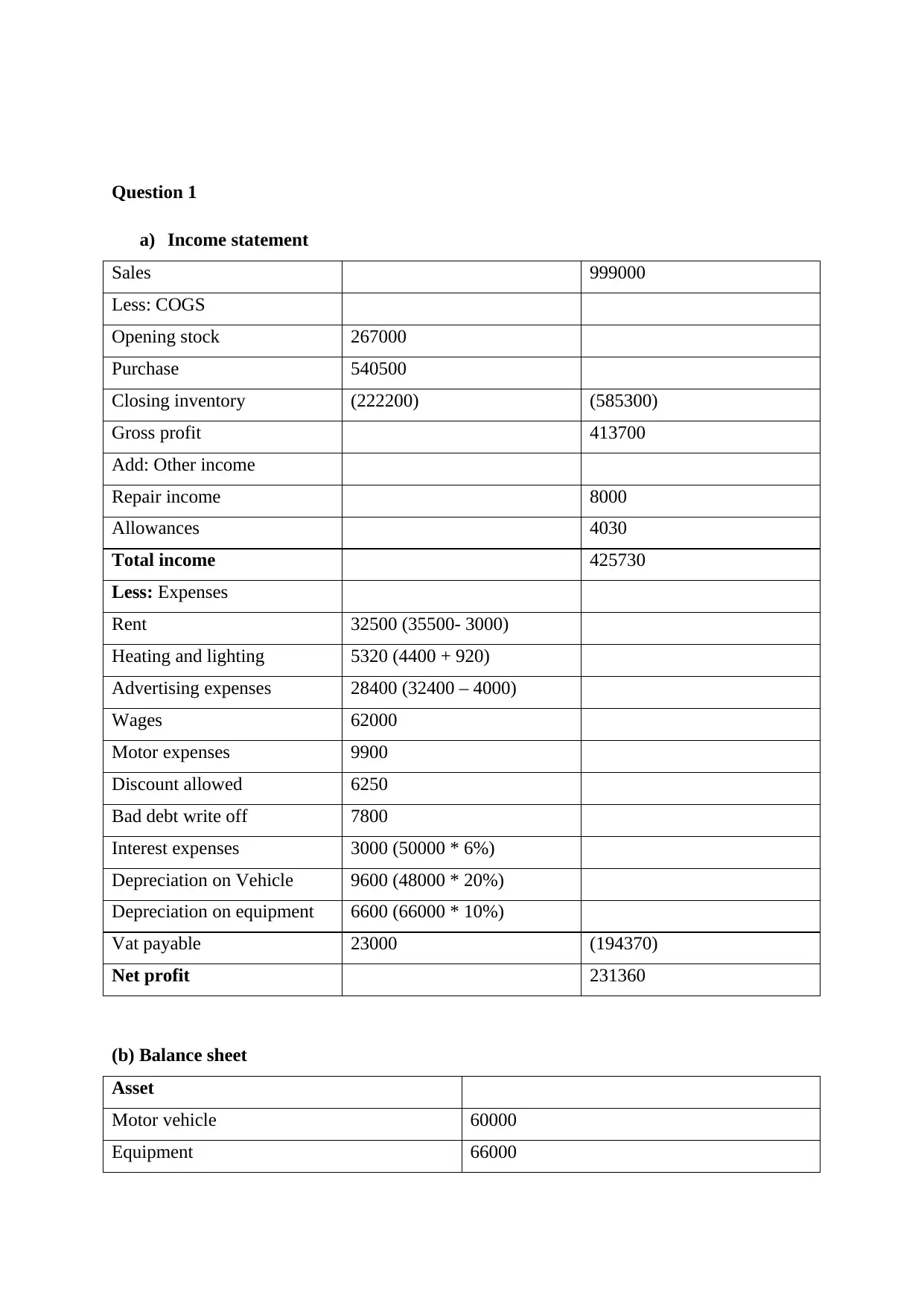
Question 1
a) Income statement
Sales 999000
Less: COGS
Opening stock 267000
Purchase 540500
Closing inventory (222200) (585300)
Gross profit 413700
Add: Other income
Repair income 8000
Allowances 4030
Total income 425730
Less: Expenses
Rent 32500 (35500- 3000)
Heating and lighting 5320 (4400 + 920)
Advertising expenses 28400 (32400 – 4000)
Wages 62000
Motor expenses 9900
Discount allowed 6250
Bad debt write off 7800
Interest expenses 3000 (50000 * 6%)
Depreciation on Vehicle 9600 (48000 * 20%)
Depreciation on equipment 6600 (66000 * 10%)
Vat payable 23000 (194370)
Net profit 231360
(b) Balance sheet
Asset
Motor vehicle 60000
Equipment 66000
a) Income statement
Sales 999000
Less: COGS
Opening stock 267000
Purchase 540500
Closing inventory (222200) (585300)
Gross profit 413700
Add: Other income
Repair income 8000
Allowances 4030
Total income 425730
Less: Expenses
Rent 32500 (35500- 3000)
Heating and lighting 5320 (4400 + 920)
Advertising expenses 28400 (32400 – 4000)
Wages 62000
Motor expenses 9900
Discount allowed 6250
Bad debt write off 7800
Interest expenses 3000 (50000 * 6%)
Depreciation on Vehicle 9600 (48000 * 20%)
Depreciation on equipment 6600 (66000 * 10%)
Vat payable 23000 (194370)
Net profit 231360
(b) Balance sheet
Asset
Motor vehicle 60000
Equipment 66000
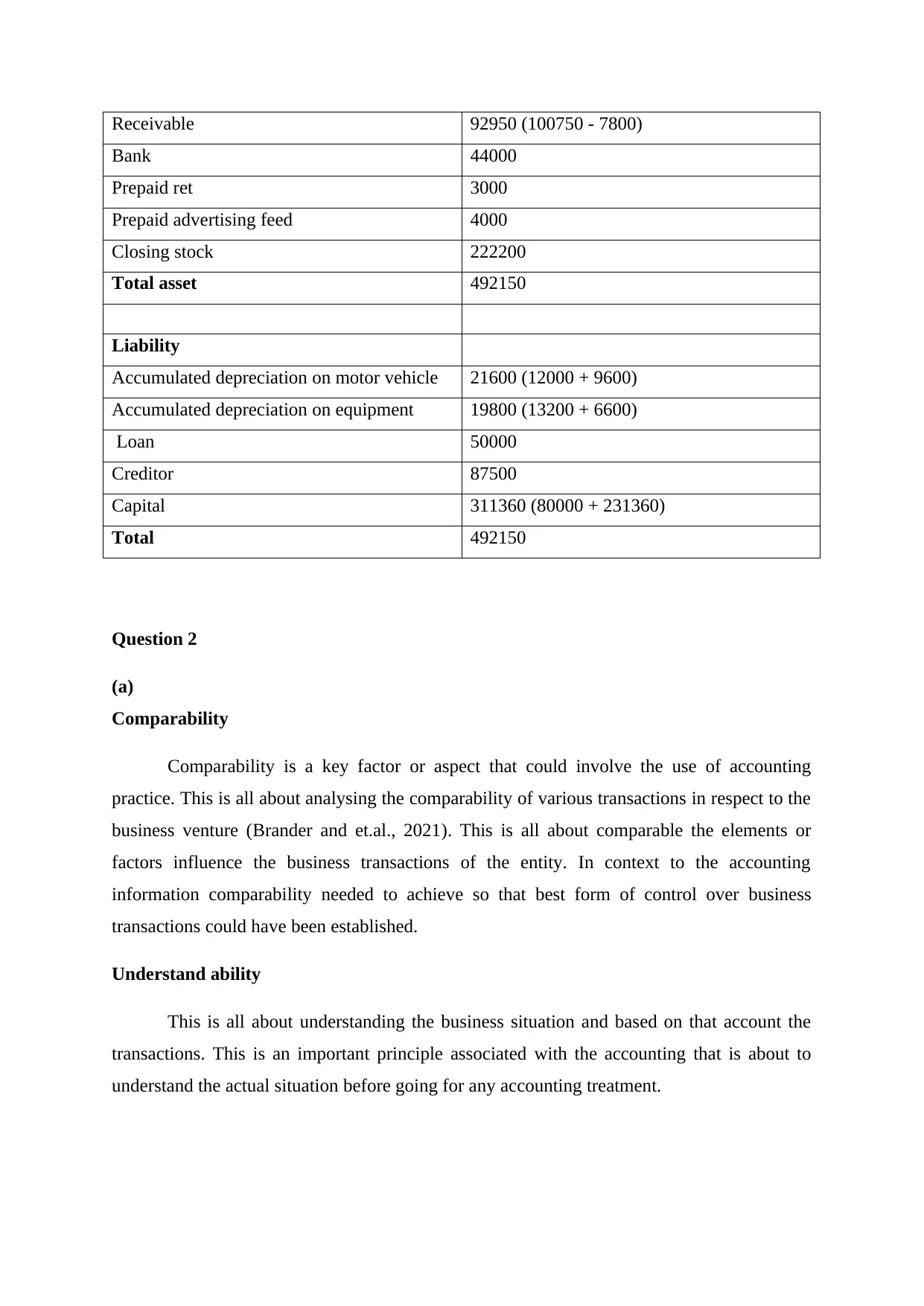
Receivable 92950 (100750 - 7800)
Bank 44000
Prepaid ret 3000
Prepaid advertising feed 4000
Closing stock 222200
Total asset 492150
Liability
Accumulated depreciation on motor vehicle 21600 (12000 + 9600)
Accumulated depreciation on equipment 19800 (13200 + 6600)
Loan 50000
Creditor 87500
Capital 311360 (80000 + 231360)
Total 492150
Question 2
(a)
Comparability
Comparability is a key factor or aspect that could involve the use of accounting
practice. This is all about analysing the comparability of various transactions in respect to the
business venture (Brander and et.al., 2021). This is all about comparable the elements or
factors influence the business transactions of the entity. In context to the accounting
information comparability needed to achieve so that best form of control over business
transactions could have been established.
Understand ability
This is all about understanding the business situation and based on that account the
transactions. This is an important principle associated with the accounting that is about to
understand the actual situation before going for any accounting treatment.
Bank 44000
Prepaid ret 3000
Prepaid advertising feed 4000
Closing stock 222200
Total asset 492150
Liability
Accumulated depreciation on motor vehicle 21600 (12000 + 9600)
Accumulated depreciation on equipment 19800 (13200 + 6600)
Loan 50000
Creditor 87500
Capital 311360 (80000 + 231360)
Total 492150
Question 2
(a)
Comparability
Comparability is a key factor or aspect that could involve the use of accounting
practice. This is all about analysing the comparability of various transactions in respect to the
business venture (Brander and et.al., 2021). This is all about comparable the elements or
factors influence the business transactions of the entity. In context to the accounting
information comparability needed to achieve so that best form of control over business
transactions could have been established.
Understand ability
This is all about understanding the business situation and based on that account the
transactions. This is an important principle associated with the accounting that is about to
understand the actual situation before going for any accounting treatment.
Secure Best Marks with AI Grader
Need help grading? Try our AI Grader for instant feedback on your assignments.
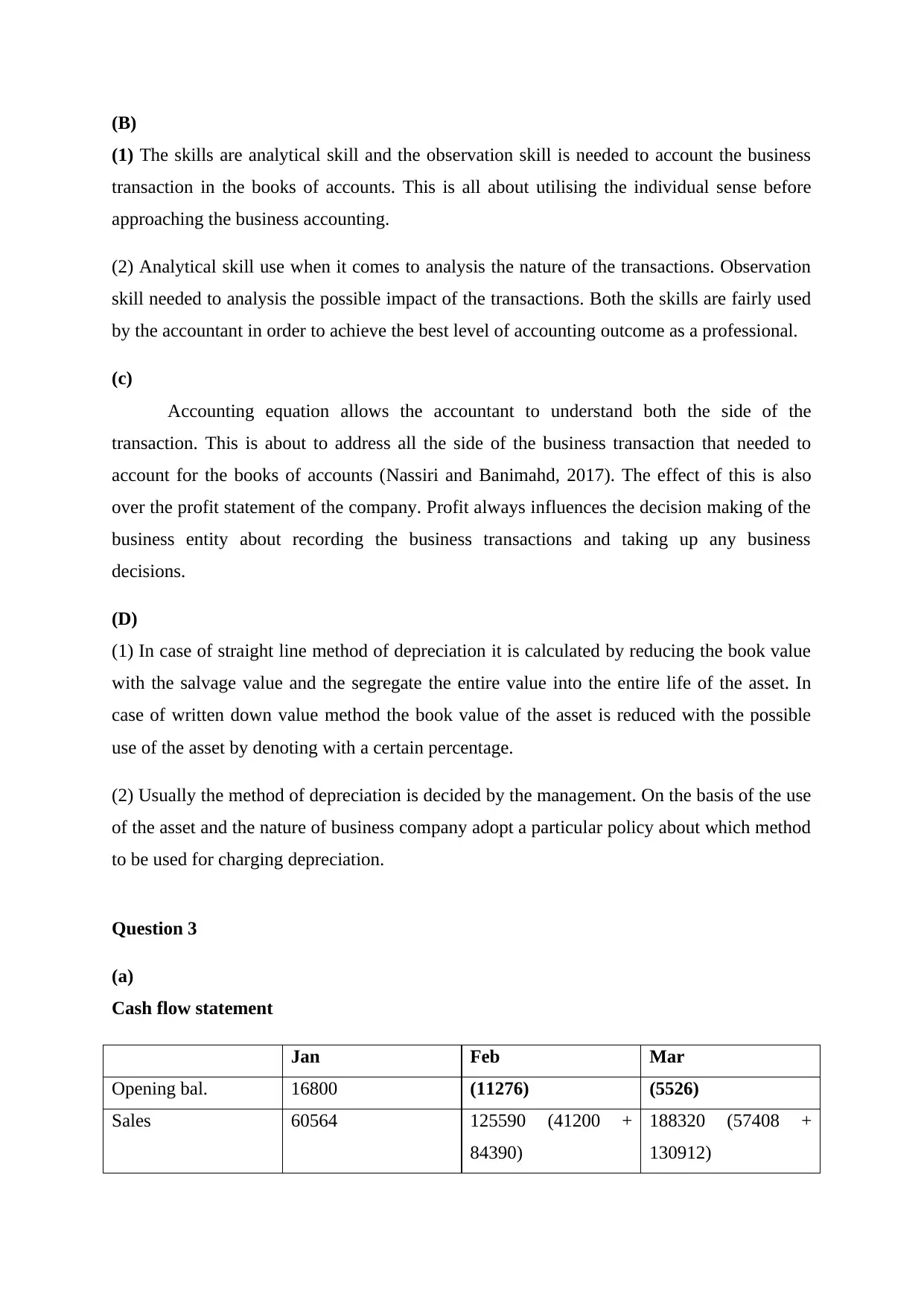
(B)
(1) The skills are analytical skill and the observation skill is needed to account the business
transaction in the books of accounts. This is all about utilising the individual sense before
approaching the business accounting.
(2) Analytical skill use when it comes to analysis the nature of the transactions. Observation
skill needed to analysis the possible impact of the transactions. Both the skills are fairly used
by the accountant in order to achieve the best level of accounting outcome as a professional.
(c)
Accounting equation allows the accountant to understand both the side of the
transaction. This is about to address all the side of the business transaction that needed to
account for the books of accounts (Nassiri and Banimahd, 2017). The effect of this is also
over the profit statement of the company. Profit always influences the decision making of the
business entity about recording the business transactions and taking up any business
decisions.
(D)
(1) In case of straight line method of depreciation it is calculated by reducing the book value
with the salvage value and the segregate the entire value into the entire life of the asset. In
case of written down value method the book value of the asset is reduced with the possible
use of the asset by denoting with a certain percentage.
(2) Usually the method of depreciation is decided by the management. On the basis of the use
of the asset and the nature of business company adopt a particular policy about which method
to be used for charging depreciation.
Question 3
(a)
Cash flow statement
Jan Feb Mar
Opening bal. 16800 (11276) (5526)
Sales 60564 125590 (41200 +
84390)
188320 (57408 +
130912)
(1) The skills are analytical skill and the observation skill is needed to account the business
transaction in the books of accounts. This is all about utilising the individual sense before
approaching the business accounting.
(2) Analytical skill use when it comes to analysis the nature of the transactions. Observation
skill needed to analysis the possible impact of the transactions. Both the skills are fairly used
by the accountant in order to achieve the best level of accounting outcome as a professional.
(c)
Accounting equation allows the accountant to understand both the side of the
transaction. This is about to address all the side of the business transaction that needed to
account for the books of accounts (Nassiri and Banimahd, 2017). The effect of this is also
over the profit statement of the company. Profit always influences the decision making of the
business entity about recording the business transactions and taking up any business
decisions.
(D)
(1) In case of straight line method of depreciation it is calculated by reducing the book value
with the salvage value and the segregate the entire value into the entire life of the asset. In
case of written down value method the book value of the asset is reduced with the possible
use of the asset by denoting with a certain percentage.
(2) Usually the method of depreciation is decided by the management. On the basis of the use
of the asset and the nature of business company adopt a particular policy about which method
to be used for charging depreciation.
Question 3
(a)
Cash flow statement
Jan Feb Mar
Opening bal. 16800 (11276) (5526)
Sales 60564 125590 (41200 +
84390)
188320 (57408 +
130912)
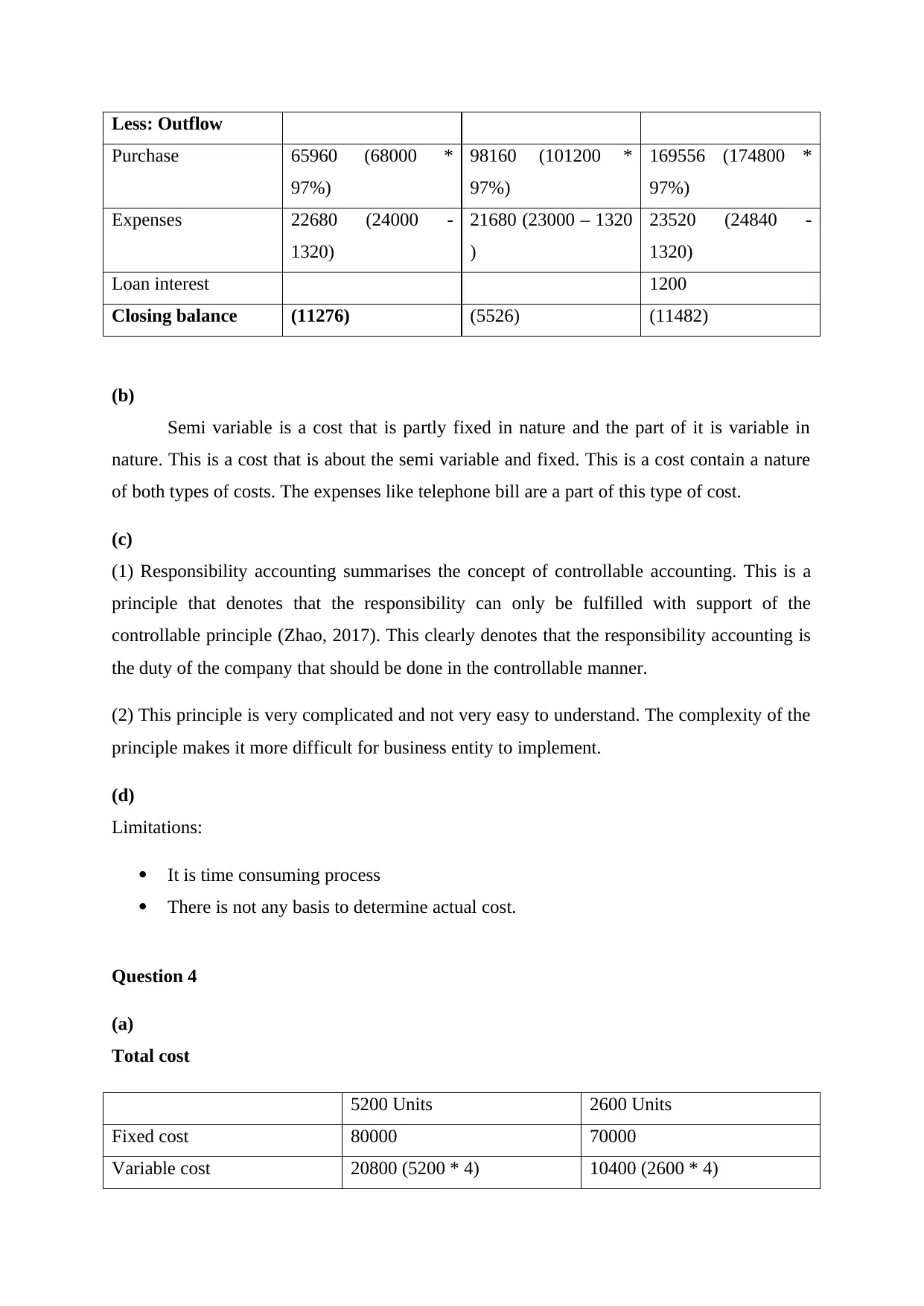
Less: Outflow
Purchase 65960 (68000 *
97%)
98160 (101200 *
97%)
169556 (174800 *
97%)
Expenses 22680 (24000 -
1320)
21680 (23000 – 1320
)
23520 (24840 -
1320)
Loan interest 1200
Closing balance (11276) (5526) (11482)
(b)
Semi variable is a cost that is partly fixed in nature and the part of it is variable in
nature. This is a cost that is about the semi variable and fixed. This is a cost contain a nature
of both types of costs. The expenses like telephone bill are a part of this type of cost.
(c)
(1) Responsibility accounting summarises the concept of controllable accounting. This is a
principle that denotes that the responsibility can only be fulfilled with support of the
controllable principle (Zhao, 2017). This clearly denotes that the responsibility accounting is
the duty of the company that should be done in the controllable manner.
(2) This principle is very complicated and not very easy to understand. The complexity of the
principle makes it more difficult for business entity to implement.
(d)
Limitations:
It is time consuming process
There is not any basis to determine actual cost.
Question 4
(a)
Total cost
5200 Units 2600 Units
Fixed cost 80000 70000
Variable cost 20800 (5200 * 4) 10400 (2600 * 4)
Purchase 65960 (68000 *
97%)
98160 (101200 *
97%)
169556 (174800 *
97%)
Expenses 22680 (24000 -
1320)
21680 (23000 – 1320
)
23520 (24840 -
1320)
Loan interest 1200
Closing balance (11276) (5526) (11482)
(b)
Semi variable is a cost that is partly fixed in nature and the part of it is variable in
nature. This is a cost that is about the semi variable and fixed. This is a cost contain a nature
of both types of costs. The expenses like telephone bill are a part of this type of cost.
(c)
(1) Responsibility accounting summarises the concept of controllable accounting. This is a
principle that denotes that the responsibility can only be fulfilled with support of the
controllable principle (Zhao, 2017). This clearly denotes that the responsibility accounting is
the duty of the company that should be done in the controllable manner.
(2) This principle is very complicated and not very easy to understand. The complexity of the
principle makes it more difficult for business entity to implement.
(d)
Limitations:
It is time consuming process
There is not any basis to determine actual cost.
Question 4
(a)
Total cost
5200 Units 2600 Units
Fixed cost 80000 70000
Variable cost 20800 (5200 * 4) 10400 (2600 * 4)
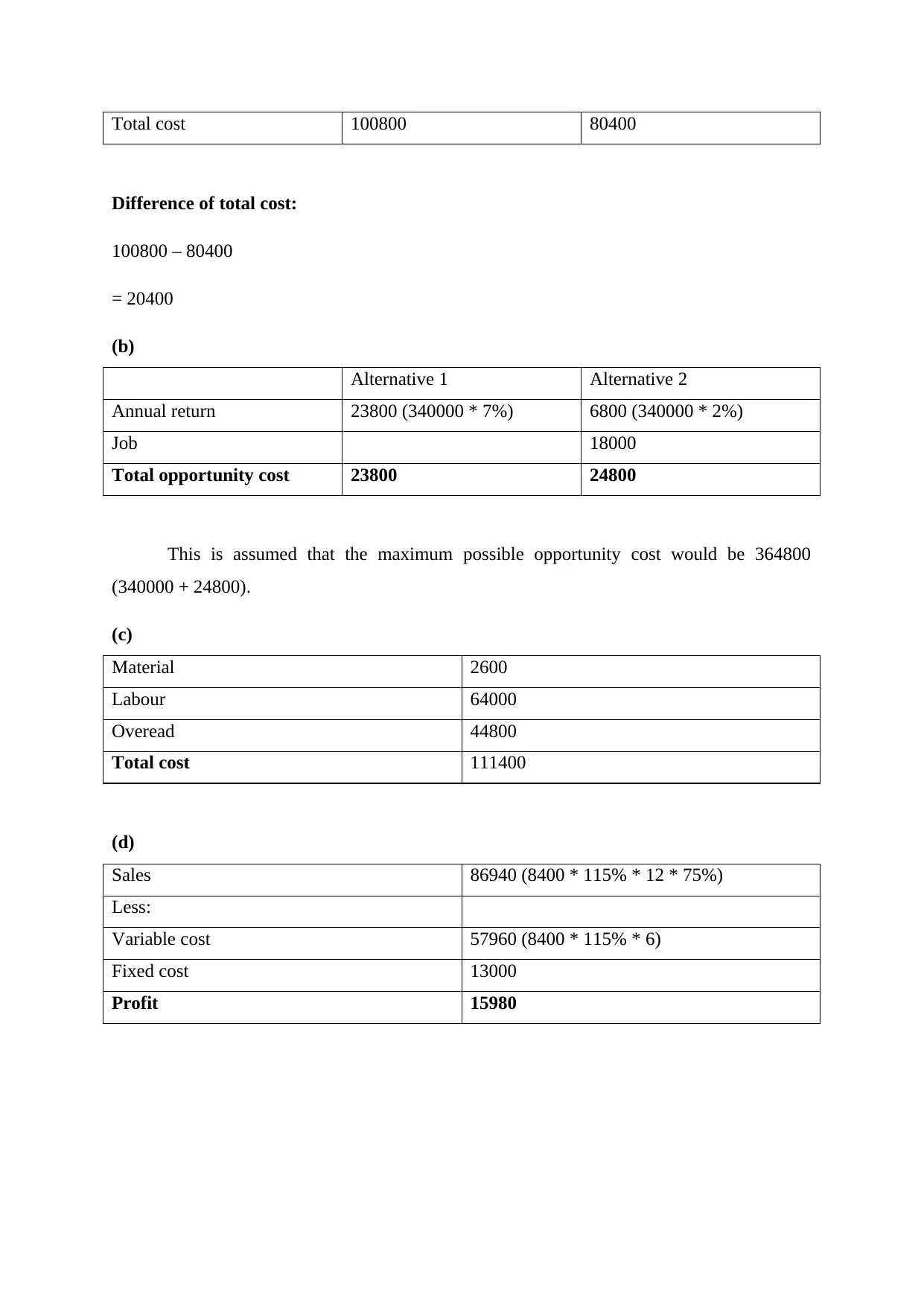
Total cost 100800 80400
Difference of total cost:
100800 – 80400
= 20400
(b)
Alternative 1 Alternative 2
Annual return 23800 (340000 * 7%) 6800 (340000 * 2%)
Job 18000
Total opportunity cost 23800 24800
This is assumed that the maximum possible opportunity cost would be 364800
(340000 + 24800).
(c)
Material 2600
Labour 64000
Overead 44800
Total cost 111400
(d)
Sales 86940 (8400 * 115% * 12 * 75%)
Less:
Variable cost 57960 (8400 * 115% * 6)
Fixed cost 13000
Profit 15980
Difference of total cost:
100800 – 80400
= 20400
(b)
Alternative 1 Alternative 2
Annual return 23800 (340000 * 7%) 6800 (340000 * 2%)
Job 18000
Total opportunity cost 23800 24800
This is assumed that the maximum possible opportunity cost would be 364800
(340000 + 24800).
(c)
Material 2600
Labour 64000
Overead 44800
Total cost 111400
(d)
Sales 86940 (8400 * 115% * 12 * 75%)
Less:
Variable cost 57960 (8400 * 115% * 6)
Fixed cost 13000
Profit 15980
Paraphrase This Document
Need a fresh take? Get an instant paraphrase of this document with our AI Paraphraser
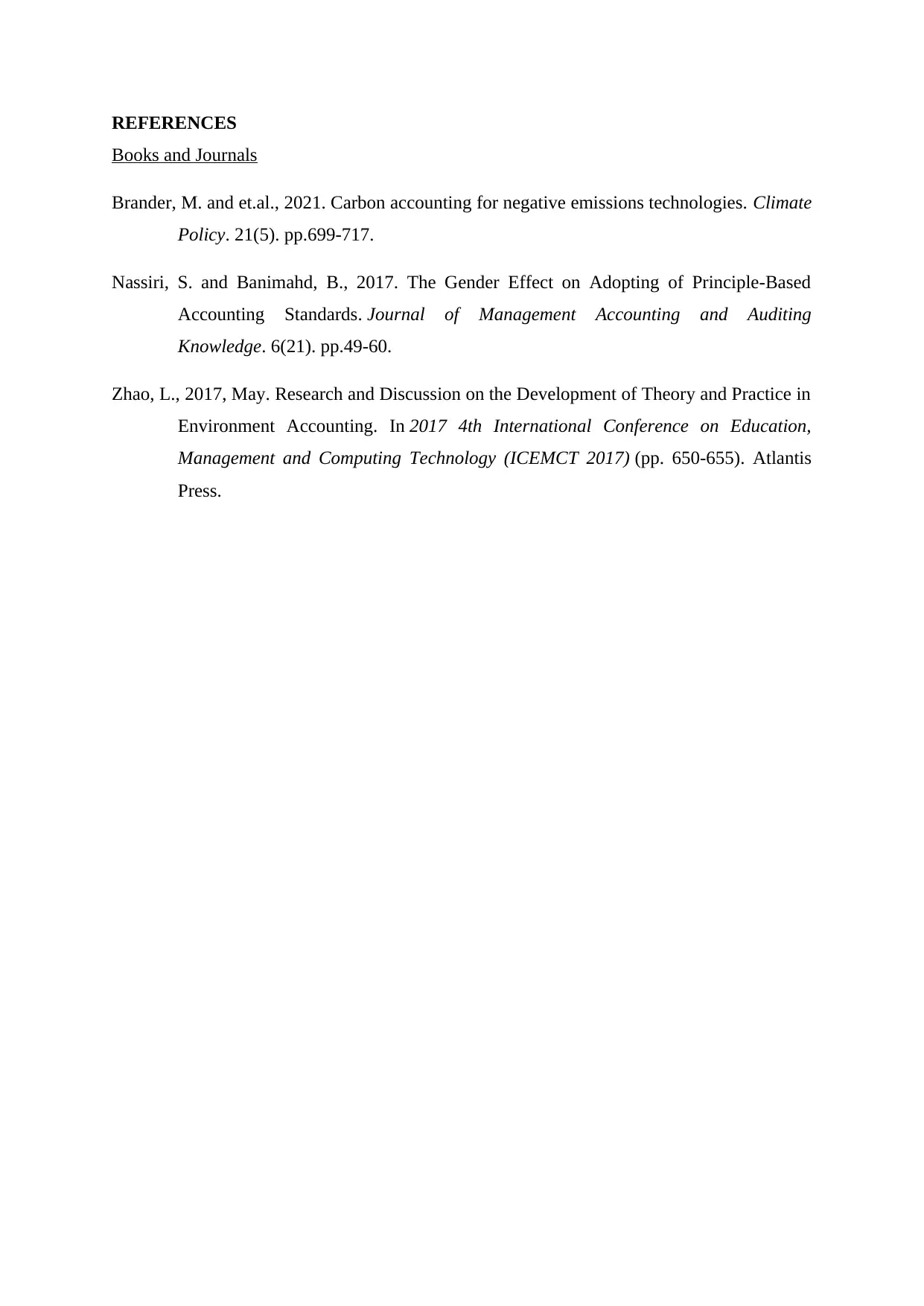
REFERENCES
Books and Journals
Brander, M. and et.al., 2021. Carbon accounting for negative emissions technologies. Climate
Policy. 21(5). pp.699-717.
Nassiri, S. and Banimahd, B., 2017. The Gender Effect on Adopting of Principle-Based
Accounting Standards. Journal of Management Accounting and Auditing
Knowledge. 6(21). pp.49-60.
Zhao, L., 2017, May. Research and Discussion on the Development of Theory and Practice in
Environment Accounting. In 2017 4th International Conference on Education,
Management and Computing Technology (ICEMCT 2017) (pp. 650-655). Atlantis
Press.
Books and Journals
Brander, M. and et.al., 2021. Carbon accounting for negative emissions technologies. Climate
Policy. 21(5). pp.699-717.
Nassiri, S. and Banimahd, B., 2017. The Gender Effect on Adopting of Principle-Based
Accounting Standards. Journal of Management Accounting and Auditing
Knowledge. 6(21). pp.49-60.
Zhao, L., 2017, May. Research and Discussion on the Development of Theory and Practice in
Environment Accounting. In 2017 4th International Conference on Education,
Management and Computing Technology (ICEMCT 2017) (pp. 650-655). Atlantis
Press.
1 out of 8
Related Documents
Your All-in-One AI-Powered Toolkit for Academic Success.
+13062052269
info@desklib.com
Available 24*7 on WhatsApp / Email
![[object Object]](/_next/static/media/star-bottom.7253800d.svg)
Unlock your academic potential
© 2024 | Zucol Services PVT LTD | All rights reserved.





